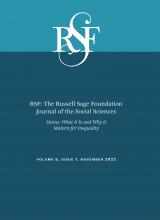Research Article
Open Access
Status Lenses: Mapping Hierarchy and Consensus in Status Beliefs
Lauren Valentino
RSF: The Russell Sage Foundation Journal of the Social Sciences November 2022, 8 (7) 89-110; DOI: https://doi.org/10.7758/RSF.2022.8.7.05
Lauren Valentino
aAssistant professor in the Department of Sociology at The Ohio State University, United States

REFERENCES
- ↵
- Accominotti, Fabien,
- Freda Lynn, and
- Michael Sauder
- ↵
- Alexander, C. Norman
- ↵
- Avent-Holt, Dustin,
- Martin Hällsten, and
- David Cort
- ↵
- Behrens, Thomas,
- Isabelle Groß,
- Jack Siemiatycki,
- David I. Conway,
- Ann Olsson,
- Isabelle Stücker,
- Florence Guida,
- Karl-Heinz Jöckel, et al
- ↵
- Benjamin, Lehn M
- ↵
- Berger, Joseph,
- Hamit Fişek,
- Robert Norman, and
- Morris Zelditch
- ↵
- ↵
- Boltanski, Luc, and
- Laurent Thévenot
- ↵
- Bourdieu, Pierre
- ↵
- Boutyline, Andrei, and
- Stephen Vaisey
- ↵
- Cameron, A. Colin, and
- Pravin K. Trivedi
- ↵
- ↵
- Christ, Sharon L.,
- Lora E. Fleming,
- David J. Lee,
- Carles Muntaner,
- Peter A. Muennig, and
- Alberto J. Caban-Martinez
- ↵
- Conley, Dalton, and
- W. Jean Yeung
- ↵
- Correll, Shelley J.,
- Cecilia L. Ridgeway,
- Ezra W. Zuckerman,
- Sharon Jank,
- Sara Jordan-Bloch, and
- Sandra Nakagawa
- ↵
- Deleuze, Gilles, and
- Félix Guattari
- ↵
- DiMaggio, Paul, and
- Hazel Rose Markus
- ↵
- Durkheim, Émile
- ↵
- Espeland, Wendy Nelson, and
- Michael Sauder
- ↵
- Espeland, Wendy Nelson, and
- Mitchell L. Stevens
- ↵
- Fiske, Susan T., and
- Hazel Rose Markus
- ↵
- Freeland, Robert E., and
- Jesse Hoey
- ↵
- ↵
- Gambetta, Diego
- ↵
- Gauchat, Gordon, and
- Kenneth T. Andrews
- ↵
- ↵
- Harding, David J
- ↵
- Jenkins, Tania M
- ↵
- Jiang, X. Lu, and
- Antonius H. N. Cillessen
- ↵
- Kahn, Kimberly,
- Arnold K. Ho,
- Jim Sidanius, and
- Felicia Pratto
- ↵
- ↵
- Koenig, Biko
- ↵
- Lamont, Michèle
- ↵
- Lamont, Michèle
- ↵
- ↵
- Leicht, Kevin T
- ↵
- ↵
- Lynn, Freda B., and
- George Ellerbach
- ↵
- ↵
- Maloney, Emily K
- ↵
- Maloney, Emily K.,
- Kimberly B. Rogers, and
- Lynn Smith-Lovin
- ↵
- Matthews, Karen A.,
- Katri Raikkonnen,
- Susan A. Everson,
- Janine D. Flory,
- Christine A. Marco,
- Jane F. Owens, and
- Catherine E. Lloyd
- ↵
- ↵
- McLaren, Lindsay, and
- Jenny Godley
- ↵
- Melamed, David,
- Christopher W. Munn,
- Leanne Barry,
- Bradley Montgomery, and
- Oneya F. Okuwobi
- ↵
- ↵
- Noss, Amanda
- ↵
- Parsons, Talcott, and
- Edward A. Shils
- ↵
- ↵
- Ridgeway, Cecilia L
- ↵
- Ridgeway, Cecilia L., and
- Hazel Rose Markus
- ↵
- Rogers, Kimberly B
- ↵
- Sauder, Michael
- ↵
- Smith, Tom W., and
- Jaesok Son
- ↵
- ↵
- Sterelny, Kim
- ↵
- Treiman, Donald J
- ↵
- Valentino, Lauren
- ↵
- Valentino, Lauren
- ↵
- Valentino, Lauren
- ↵
- Wang, Chi Phoenix
- ↵
- Weber, Max
- ↵
- Wegener, Bernd
- ↵
- Wickens, Thomas D
- ↵
- ↵
In this issue
Status Lenses: Mapping Hierarchy and Consensus in Status Beliefs
Lauren Valentino
RSF: The Russell Sage Foundation Journal of the Social Sciences Nov 2022, 8 (7) 89-110; DOI: 10.7758/RSF.2022.8.7.05
Jump to section
Related Articles
- No related articles found.
Cited By...
- No citing articles found.





